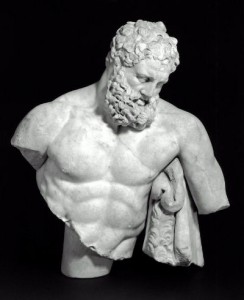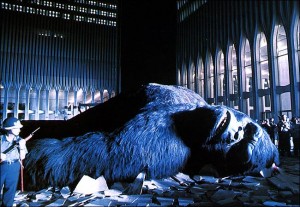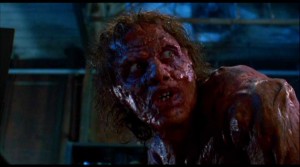(Originally posted February 10, 2009)
 I’m prepping a new project and have been spending a lot of time brushing up on the Hero’s Journey — re-reading Hero with a Thousand Faces and Story, and blasting through Christopher Vogler’s The Writer’s Journey and Blake Snyder’s Save the Cat! It all got me thinking about the Monster’s role in the traditional analysis of mythic story structure and the archetypes found therein.
I’m prepping a new project and have been spending a lot of time brushing up on the Hero’s Journey — re-reading Hero with a Thousand Faces and Story, and blasting through Christopher Vogler’s The Writer’s Journey and Blake Snyder’s Save the Cat! It all got me thinking about the Monster’s role in the traditional analysis of mythic story structure and the archetypes found therein.
This post deals with arguably the most important of these archetypes: The Hero, a story’s central protagonist; a character who displays courage and the capacity for self-sacrifice; and/or the character who “changes the most” in a story. A traditional hero begins with a fatal flaw (pride, envy, immaturity, etc.), but goes on some sort of journey that leads to self-awareness, inner transformation (i.e. overcoming his flaw), and the willingness to make a meaningful sacrifice on behalf of others. Blake Snyder also stresses the importance of synthesis: the melding of the new persona with the old to overcome a story’s final obstacles.
So, are there characters in film or literature who meet the criteria for being a monster and a hero? Can a character who ”threatens, harms, or kills us” also be capable of self-sacrifice and real transformation? Here are a few possible candidates:
King Kong
I believe Kong satisfies all the monster criteria. He represents a number of Fears, including Fear of Nature, Fear of Others, and Fear of Getting Eaten Alive. And he definitely harms humans, can’t be easily contained, and is uncanny in appearance. Yet, in all three versions of the film, he risks his life to protect the heroine. His final moments can be read as both a defiant last stand and a desperate attempt to defend the girl.
But can a character with animal intelligence really transform? Can he realize that he has a fatal flaw and overcome it? You could argue that Kong falls in love, which transforms him from murderer (presumably he ate all the other girls who were sacrificed to him) into hero. But I think that’s a stretch.
 I’d argue instead that Kong is really a “catalyst hero” – a character who doesn’t change very much during the course of the story, but whose presence and sacrifice allows others to transform. I think this is best-realized in the 1976 version, which might have the most powerful ending (gasp!): When Kong puts down Dwan (Jessica Lange), she realizes that she was the only thing keeping him alive. Without her in his grip, the planes are free to open fire. She pleads with him to pick her back up, to use her to defend himself. It’s wrenching because you know that his gorilla brain just can’t comprehend that in her world, she could actually protect him. Through Kong’s tragic fate, Dwan and her lover Jack (Jeff Bridges) realize but overcome the worst in humanity – greed, ignorance, lack of respect for Mother Nature – and survive to be together.
I’d argue instead that Kong is really a “catalyst hero” – a character who doesn’t change very much during the course of the story, but whose presence and sacrifice allows others to transform. I think this is best-realized in the 1976 version, which might have the most powerful ending (gasp!): When Kong puts down Dwan (Jessica Lange), she realizes that she was the only thing keeping him alive. Without her in his grip, the planes are free to open fire. She pleads with him to pick her back up, to use her to defend himself. It’s wrenching because you know that his gorilla brain just can’t comprehend that in her world, she could actually protect him. Through Kong’s tragic fate, Dwan and her lover Jack (Jeff Bridges) realize but overcome the worst in humanity – greed, ignorance, lack of respect for Mother Nature – and survive to be together.
Brundle-Fly
Cronenberg’s remake of The Fly is simultaneously one of the most disturbing and horrific movies ever made, and a poignant love story between two incomplete people. The love story is key: it allows us to connect with Jeff Goldblum’s Seth Brundle and revel in his transformation from awkward geek to confident superhero, and then share his terror as he becomes “Brundle-Fly.” Because we recognize Brundle’s need to be loved, to impress the girl, to be right, we spend huge swaths of the moving convincing ourselves that he’ll eventually find a way to reverse his hideous metamorphosis, even after he becomes something truly monstrous. And a Monster he is: He represents Fears of Science Gone Wrong, the Body, Disease and Infection, even Aging. By the end of the film, he is intent on “merging” with Veronica (Geena Davis), even if it will kill her and the baby she carries. And he uses his acidic vomit to cripple Stathis Borans (John Getz). He’s definitely uncanny in appearance, and his superhuman strength and agility make him difficult to contain.
Outwardly, Brundle is certainly the character who transforms the most during the film, from neurotic scientist to tireless lover to decaying hunchback to giant slime-coated fly monster. But, does he exhibit a meaningful internal transformation? And does he show a capacity for sacrifice? I’d suggest that Brundle doesn’t qualify as a “hero” in the pure sense of the word because, although he does try to turn Veronica away near the mid-point of the film, he eventually goes insane and comes after her anyway. His final act – gripping Vernoica’s shotgun and pointing it as his skull – isn’t done to protect her, but is instead a plea for release. In a moment of clarity, the monster realizes that he is dying and will never become human again, so he essentially asks for assisted suicide.
 Brundle may be a “tragic hero,” a hero who teaches us by his failure to change. But, I think the real heroes are actually Vernoica and her sleazy ex-boyfriend Stathis. In fact, it is Stathis who changes the most: he transforms from an inconsiderate letch to a guy willing to sacrifice himself for a woman he cares about deeply, even though he knows she doesn’t love him. While Brundle’s last act of “sacrifice” is mostly selfish, Stathis selflessly endures tremendous suffering in his attempt to protect Veronica.
Brundle may be a “tragic hero,” a hero who teaches us by his failure to change. But, I think the real heroes are actually Vernoica and her sleazy ex-boyfriend Stathis. In fact, it is Stathis who changes the most: he transforms from an inconsiderate letch to a guy willing to sacrifice himself for a woman he cares about deeply, even though he knows she doesn’t love him. While Brundle’s last act of “sacrifice” is mostly selfish, Stathis selflessly endures tremendous suffering in his attempt to protect Veronica.
I’m still brainstorming a few other options, but what do you think? Are there characters out there – from cinema, literature, comics, whatever – that are both “monsters” and “heroes”?

Hey – love the thoughts.
I, too have been thinking often of the ‘heroic monster’. it is perhaps the most interesting archetype, to my anyways, and i was happy to find your write-up!
a few great examples are :
Godzilla
the Hulk
Totoro – infact studio ghibli LOVES the heroic monster!
Sloth from the Goonies
etc. it can be hard to pinpoint them!
What i love so much about the Heroic Monster is that it achieves, for the most part, the same ends as the traditional Hero, though through completely different moral means, sometimes unpredicatble and scary! The duality of the Heroic Monster seems to be different in each example – though, it is this contrast that makes them so interesting.
for example, Godzilla very literally represents Nuclear Powers – our fear of them and unignorable dependence. we dont like this ominous force that could destroy us all at whim, but we certainly depend on it as a solution for OTHER problems [i.e. Ghidora, Hedora, etc. which hold their own symbolic purpose]
this grey middle ground seems so much more true to life than the pure black and white ‘hero’ and ‘villain’. nothing is that simple!
anyways great thinking!